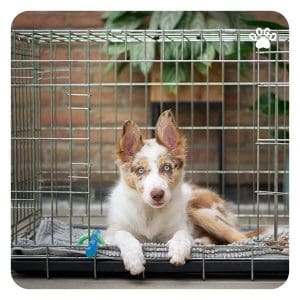
You can also read this article in Dogo App.
- Crates are a great tool, to provide your dog with a safe, puppy-proofed environment, safe spot to hide from unwanted guests and to sleep undisturbed. For instance, crates can be used to provide your dog with a safe and comfortable space when you are travelling with them. Similarly, crates can also be used to help your dog feel comfortable and secure when you are moving to a new home. Additionally, crates can be used to help your dog feel safe and relaxed during thunderstorms or other loud noises.
- A crate should be big enough, so your dog can stand up and turn around comfortably, space for food and water bowls but also small enough where they won’t have room to toilet away from their bed. Soft bedding should be placed on the bottom, so your dog can rest comfortably.It’s important to choose the right type of bedding for your dog’s crate. Some dogs may prefer a soft, plush bed, while others may prefer a firmer surface. You may need to experiment with a few different types of bedding to find out what your dog likes best. Additionally, be sure to wash the bedding regularly to keep it clean and fresh-smelling.
- Puppies age 8-10 weeks should not spend more than 30-60 minutes at a time in a crate; 11-14 weeks 1-3 hours; 15-16 weeks 4 hours, 17+ weeks 5 hours.
- Once you buy a crate, leave it with doors open for a few days, so your dog has enough time to inspect it on his own. If you see your dog investigating the crate, praise him or give some treats for the curious behaviour.
- Before and after crating for the night, your dog should get at least 30 minutes of physical exercise. Physical exercise is crucial for a dog’s overall health and well-being. In addition to preventing obesity, regular exercise can help dogs maintain healthy bones and joints, improve their cardiovascular health, and reduce stress and anxiety. Some great ways to exercise your dog include going for a walk or run, playing fetch, or engaging in interactive games like tug-of-war or hide-and-seek.
- Move from one step to the next step only if your dog is calm and relaxed. : If your dog seems anxious or stressed while being crated, it’s important to take a step back and move more slowly through the training process. Do not rush. Remember that crate is a safe paradise for your dog and never should be used as a punishment tool. This can cause your dog to develop negative associations with the crate. Instead, focus on creating positive associations by providing treats, praise, and comfortable bedding inside the crate.
- Do not crate your dog only when you leave home, so your dog does not associate your absence with the crate. When you are at home provide some random time periods of crating.
- Do not act excited when the dog leaves the crate, this should be no big deal. Be neutral in your body language.






